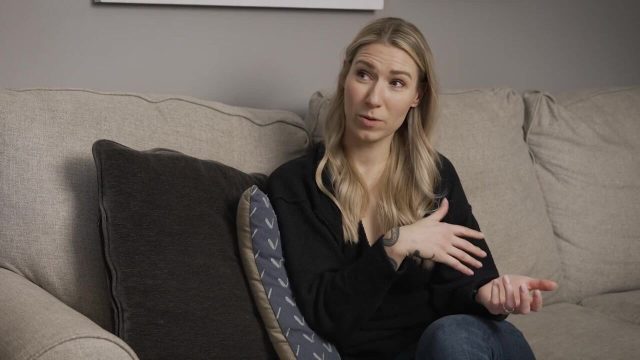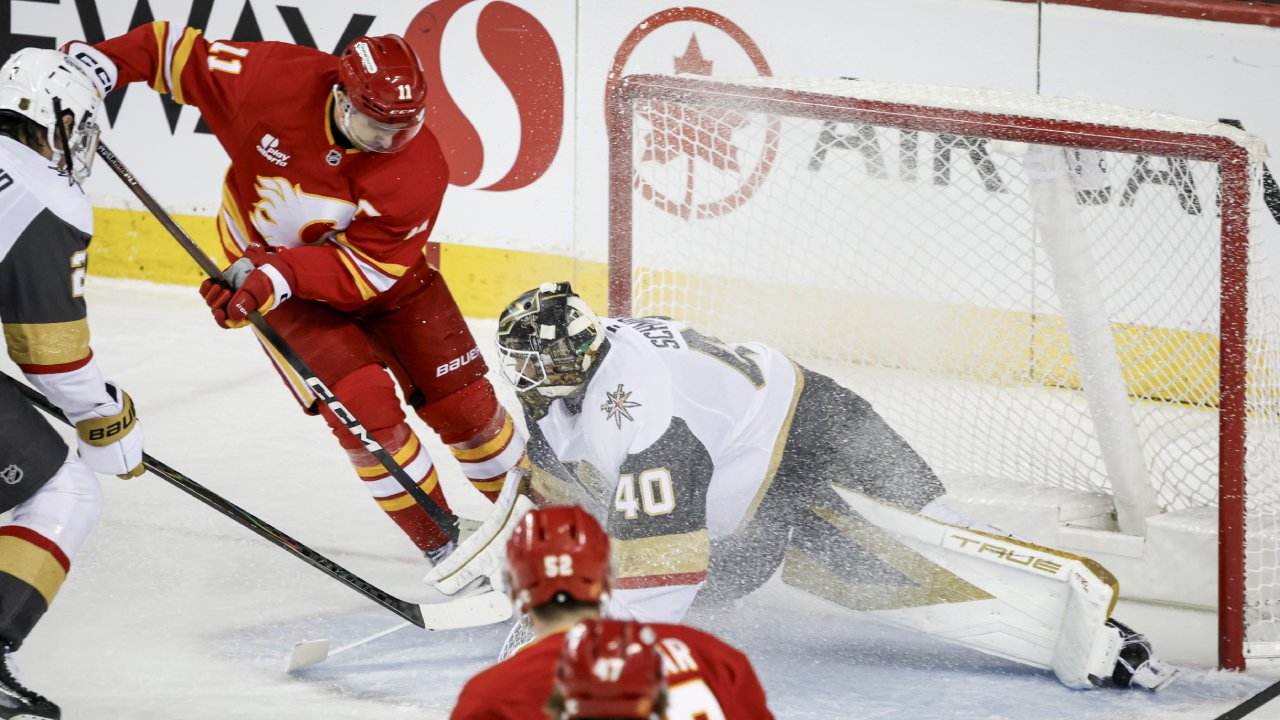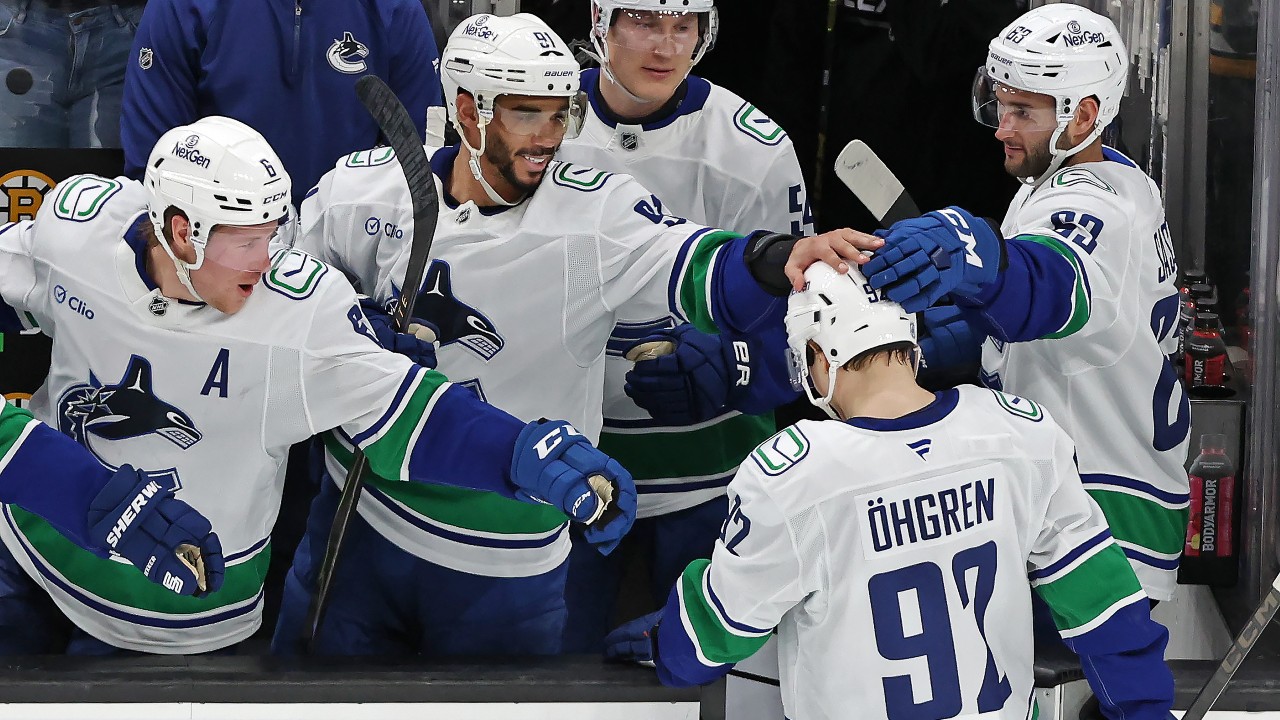
JUST WHEN SHE THOUGHT SHE WAS OUT
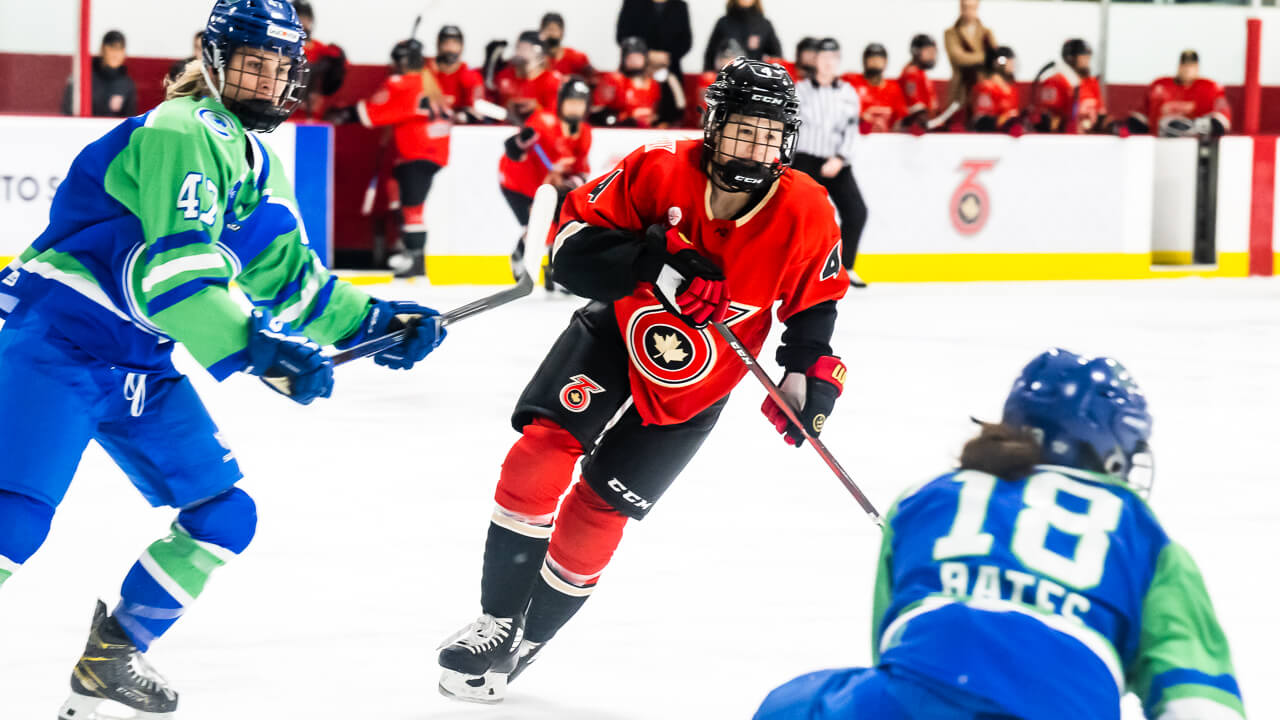
D
aryl Watts was sitting on the team bus, fresh off an elimination loss to Northeastern that had ended her Wisconsin Badgers’ hopes of repeating as national champions. It was March 2022, and the NCAA Division-I star was disappointed, sure of one thing about the road ahead of her, and fielding questions from her teammates.
“Daryl, you’re really done with hockey now?,” they asked. “You’re never going to play again?”
Having long made peace with a future outside the game, she answered with a shrug and a laid-back, “… yeah.”
The winger had led her college club in scoring five years straight and never dipped below a point-per-game pace. Her 297 career points placed her second on the all-time NCAA scoring list. She was 22 years old and at the top of her sport. And Daryl Watts was done with hockey.
“That whole year, I knew that at the end of the season, I was done,” says Watts. “I feel like people would expect me to say, like, ‘Ah, I’m so sad’ after every game [that season]because I knew I had one less game, but I wasn’t.
“Leaving this hockey bubble … I was excited just to open myself up to the world and see what was out there.”
While hockey had been her life’s work, it was never her intention to make it a career. Sure, she loved the game, but could she earn a living playing it? Whenever Watts envisioned the lifestyle she wanted to lead and family she hoped to have, she’d been keenly aware that playing professional hockey was not going to help make it a reality.
“I’ve always wanted to have a really great career. I’m really competitive with hockey, so [I wanted] to kind of use that drive, channel that into a new career and see how successful I could be,” she says. “But last year, at the time, I didn’t think that pursuing professional women’s hockey could set me down the path of, you know, achieving a really comfortable lifestyle and also creating wealth for my kids.”
She’d long understood that while her male peers could expect lucrative contracts at various levels of professional hockey, her potential earnings were limited, her dreams fueled by her passion for the game. While the Premier Hockey Federation had made some significant financial strides and the Professional Women’s Hockey Players Association’s ongoing campaign for a sustainable stage for some of the game’s top players was rumoured to be ever closer to a solution, Watts didn’t view either path as the right one for her.
So, upon the conclusion of her college career, the Division-I standout stepped away from the game. A career in commercial real estate was, she felt, the more financially viable option.
The Toronto native couldn’t know that less than a year later, she’d be stepping onto the ice at York’s Canlan Sports Arena, donning No. 4 as the newest member of the PHF’s Toronto Six. Her contract, a two-year pact made official on Jan. 19, carries an average annual value of $88,500 and pays Watts a record $150,000 for 2023-24 — the highest salary ever announced for a professional women’s hockey player in North America, surpassing the groundbreaking $80,000 deal signed by Buffalo Beauts forward Mikyla Grant-Mentis in September. It’s also the first sign of what player compensation could look like in the wake of the PHF’s December announcement that its $750,000 salary cap for 2022-23 will double to $1.5 million starting next season.
Watts thought she was done with hockey — she thought she had to be. “But the doubling of the salary cap in December kind of changed my perspective,” she says.
That she’s back in the game she loves and building towards the future she wants marks a new chapter, not just for Watts but for elite female hockey players everywhere. She believes her record-setting contract is just the beginning, and that many more of her peers will ink unprecedented deals this summer in what is poised to be the league’s most lucrative off-season yet.
But first, she’s got a championship to play for. And while money talks, she’s hoping her play will speak for itself.
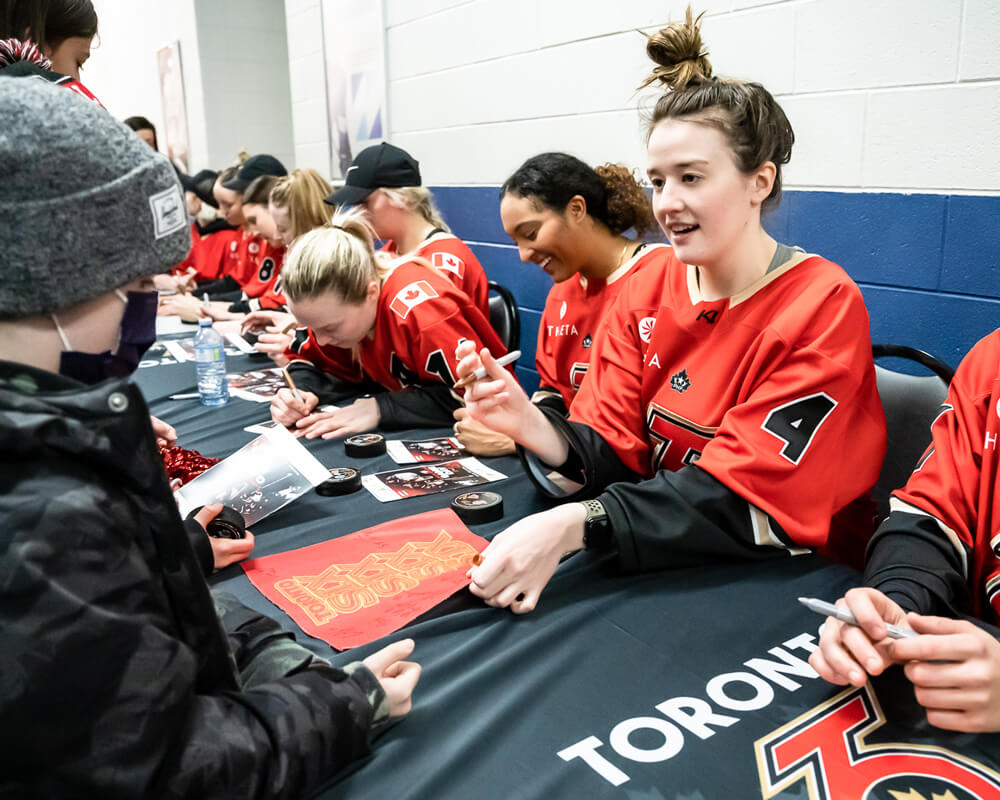
W
atts walks into a large viewing room at Canlan Sports before practice in mid-February wearing heather grey sweatpants and a black puffer jacket, her long brown hair gathered into a messy bun. There’s always something happening at the bustling York hockey hub, the six-pad arena that is Watts’ new hockey home, but here it’s quiet. There’s a line of chairs along the wall-to-wall plexiglass window. She sits down, propping her feet on the window’s ledge, and looks out over a pair of fresh sheets awaiting their next skaters. Just six games into her PHF career, Watts is still getting used to a life back in hockey, but she looks right at home. She is home, after all.
Watts grew up in Etobicoke’s Kingsway neighbourhood. It was there, on the backyard rink built by her dad, that she first donned skates at age two or three, motivated — as so many younger siblings are — to follow in the strides of her older brother.
“If he’d never played hockey I don’t know if I would have ever played,” she says. “I mean, hockey’s so crazy in Toronto, maybe I would have. But I just wanted to do everything my brother did.”
Out there on the backyard rink each winter, she wasn’t just Jackson’s little sister — she was Mats Sundin, her favourite Maple Leaf; she was Sidney Crosby, fresh off his rookie season in the NHL.
“My dad has some stories about like, just me being on the backyard rink really late at night by myself scoring goals and then celebrating to no one” she says with a laugh. “And it would be freezing out and I would never come inside.”
Soon, it was clear that Watts didn’t need to pretend to be a star, she was one. Out there on the ice at rinks across the GTA — while playing on her brother’s minor league team, while rising through the AA system with the Toronto Aeros and Mississauga Chiefs of the Provincial Women’s Hockey League — she was Daryl Watts, member of Team Canada’s U-18 team and future college hockey standout.
“I think when I was really young, I wanted to play in the NHL,” she says. “But then as I got a bit older, I was like, ‘I’m a girl — I can’t play in the NHL, so I’m just going to play because I love hockey.’ And then it was probably, ‘Oh, I want to be an Olympian and go to an NCAA D-I school.’”
Her dad, Michael, recognized his daughter’s talent and love for the game early on and started bringing in skills coaches for her and her brother.
“I would say he’s pretty intense, and my biggest fan,” Watts says of her dad, a corporate lawyer in Toronto. She jokes that he’s felt like her agent from Day One, advocating for his daughter and seeking out every resource available to help her thrive. Mom, Barbara, has also always been supportive of every endeavour, “but I would say my dad’s more intense.
“From really early on, he was putting me in extra skill sessions — like, literally from the time I was five years old. On that backyard rink he built, he would have skating coaches come out for my brother and I, to shoot on the net and all that stuff,” she says.
Watts recalls the first moment her Division-I dream felt within reach. At a summer tournament during her time playing for the Toronto Aeros of the Provincial Women’s Hockey League, an Ivy-League head coach approached her and Michael post-game.
“She talked to my dad in the parking lot and was like, ‘You know, your daughter’s really good … there’s opportunities for her to go to D-I schools.’” Watts says. “That was kind of like a ‘woah’ moment for us, because it was like, ‘Oh my gosh, the best university in the world, they want me to come to their school?’
“That was eye-opening.”
J
ust a few years later, all eyes were on the freshman forward as she burst onto the NCAA Division-I scene after securing a full scholarship at her school of choice, Boston College. Suiting up on the Eagles’ top line alongside centre Caitrin Lonergan in 2017-18, an 18-year-old Watts put up historic numbers: 42 goals and 82 points in 38 games, including 25 multi-point and 11 multi-goal games. She was held off the scoresheet just twice all year, averaging more than two points per game, and concluded the campaign as the national scoring leader while setting new records for the most goals, assists, and points by a freshman in Hockey East, the New England-based college conference in which the Eagles play. She also matched the conference records for most goals and points in a single season by a player of any age. Her 2017-18 season totals remain the second-best in Eagles’ history.
“That was a really special year,” says Watts, who earned NCAA rookie-of-the-year honours for her efforts as well as the Cammi Granato Award as Hockey East’s best player before topping it all off with the Patty Kazmaier Award, given annually to the best player in all of college women’s hockey. She remains the only underclassman to ever win the award.
And yet, the season still disappointed Watts, whose Eagles were knocked out as the No. 1 seed in the second round of the divisional playoffs and then ousted by Ohio State in the Elite Eight of the NCAA tournament.
“That really stung,” she says. She pauses, like that first college playoff loss is still fresh, and then describes a scene that’s fueled her ever since. She’d flown to Minnesota for the Kazmaier Award ceremony, held on the Saturday of championship weekend, and after accepting was on a flight back to Boston.
“So I was at home, a Patty Kaz winner … And I just remember [thinking], ‘What does it even mean to be a Patty Kaz if you’re not at the championship weekend with your teammates competing for the title?’
“Like, I would rather have the championship than this title. I was happy … but I wanted more,” she says. “I just had this moment, and I can remember it being like, ‘This is great, but like, I’m not as happy as I should be because I wanted our team to be playing that weekend.”
Her sophomore year ended in similar fashion with another early post-season exit for the Eagles. It also presented Watts with a series of individual setbacks right from the start. The return of a handful of U.S. Olympians post-PyeongChang centralization saw her separated from Lonergan, stripped of her power-play role, and spending half the season on the fourth line with a steep drop in playing time. Still, she led the squad in points. But it was a struggle.
“I wasn’t excited to go to the rink,” says Watts of her sophomore year. “I just kind of fell out of love with hockey.”
She knew she needed to make a change. So, when Lonergan made the decision to enter the transfer portal — a rare move among women’s players, and even rarer among the game’s notable stars — Watts decided she would do the same. Three (nervous) days after declaring her intention to transfer, she heard from the school she’d hoped would come calling: Wisconsin, powerhouse program and reigning national champs.
Like she had at Boston College, Watts wasted no time acquainting herself with her new surroundings upon joining the Badgers, producing offence early and often and leading the team in assists (49) and points (74) while averaging 2.06 points a game and landing herself back in the Patty Kazmaier conversation as a top-10 finalist. When the 2020 NCAA tournament was cancelled due to COVID-19, it meant waiting for another crack at her ultimate goal, but she got there the following spring when, after a condensed regular season, she helped lead Wisconsin to a national championship, topping it off with the overtime game-winner in the final.
“I don’t even know how to describe it,” she says, beaming. “We did what we set out to do, what we’d been working towards for the past two years. It was just incredible.”
By the end of her third year at Wisconsin and fifth college season overall, Watts had put together one of the finest resumes in the game, leading her team in points all five years and finishing as a Patty Kazmaier finalist four times (including another top-three nod in 2020-21). But on that post-loss bus ride to the airport, surrounded by her fellow Badgers, overlooked by Canada’s national women’s team and unable to see a future in which she could make a viable living as a pro, she did what far too many elite female hockey players do before they even have a chance to enter their prime: She made it official and hung up her skates, intent on turning the page.
She’d been accepted into a Master’s program at Wisconsin to pursue commercial real estate, but got cold feet just a few days before she was to start, the decision not quite sitting right with her. Instead, she spent that fall at home in Toronto, wanting to see what else might be out there and looking up programs more closely related to her passions in television and film production.
And then, in December, she saw the news that would change her entire outlook on her future, reopening a door she thought had been locked for good.
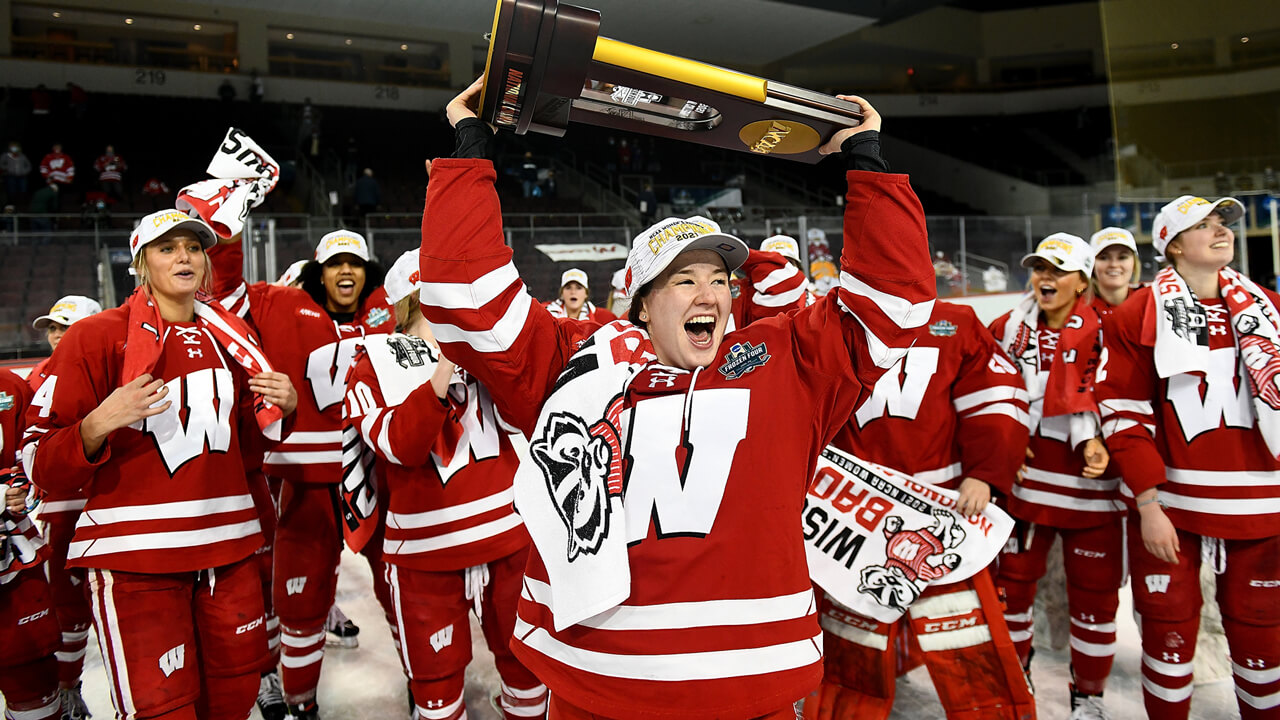
T
oronto Six general manager Angela James was at the team’s staff Christmas party when she got word of the PHF doubling its salary cap for the 2023-24 season — “a beautiful Christmas present,” says the first-year GM of the well-timed news. “I said, ‘Oh, I guess everybody likes me now!’”
The jump to $1.5 million in 2023-24 marked the third significant cap hike in as many years, making for a 900-per cent overall increase since 2020-21, when it was set at $150,000. That progress is the most outward-facing sign of the steady financial growth the league has seen of late, and an impressive follow-up to the January 2022 announcement of a $25-million commitment from its board of directors to be used for direct payments and benefits to players over the three years to follow. It also gives the PHF the largest salary cap of any women’s professional sports league in North America. (The WNBA’s salary cap for 2023 is $1.42 million, though with fewer players per roster their athletes earn higher salaries on average. Based on the latest CBA, which sets the cap growth at three per cent annually, the WNBA’s cap will reach $1.5 million in 2025.)
Shortly after the new year, another exciting development landed in James’s inbox. Watts had reached out, exploring the idea of suiting up for the Six for the 2023-24 season.
James was excited, and immediately intrigued. She’d reached out to Watts last spring to ask about her future plans in the game and whether she would be interested in playing for the Six in 2022-23. “When I spoke with her, she had indicated that she was no longer going to play hockey, which I thought was kind of shocking,” James says. While the GM admits she “didn’t really understand” the reasons behind Watts’ early retirement, she respected the decision and moved on.
“I know that her initial reasoning was because she felt that she couldn’t make a living. A lot of these girls coming out of pretty prestigious schools with great educations, you know, are you gonna play hockey full-time and make $30,000, $40,000, $50,000, $70,000, where they can work full-time [outside of hockey], make $100,000, $150,000 and, you know, start their careers?” James says. “Even this year, that was, I think, a bit of a balancing act for even some of our existing players, even though they were making a half-decent wage. But, you know, to give up their careers to play full-time — because the expectations now, on full-time, I don’t think a lot of people understand the grind, what it takes to play professional … You’re expected to be there, whether you’re injured, sick or missing a limb.”
After a positive first phone call in early January, Watts and James spoke again — this time, with Michael taking on the role of agent to talk numbers. Watts had also reached out to other teams — it was initially a four-horse race between Boston, Buffalo, Connecticut and Toronto — but in her mind, Toronto was the one that stood out from the start.
“Right from the beginning, Toronto was my number one choice,” says Watts. While she also looked into the PWHPA — she’d heard the reports over the past year of the association’s plan to launch a league with the help of investors — she never had any talks with the organization, choosing to focus her efforts on the PHF.
“Just the growth of the league impressed me the most, I’d say. What other pro league in the entire world sees growth like this?” she says. “There’s something to believe in there.”
James doesn’t take for granted the fact she’s able to be the one not just rewarding some of the game’s most talented players but bringing them back to the rink overall.
“I just thought it was just absolutely phenomenal, even last year when I just started in the position … the fact that I was able to hand out salaries that I handed out last year for the girls to play hockey,” says James. “We never had a professional league when I was growing up, so the fact that I’m able to still be a part of this journey with the PHF and what they’re doing and the ownerships and the sponsorships and everybody who’s really seeing this league take off.”
James sees Watts’ signing as a continuation of the league’s rapid growth.
“You bring in the salaries, you’re going to attract the talent pool, and then that’s going to elevate the game and that’s going to bring in the sponsorships. And then from there, you elevate again, salaries, you bring in more talent, because this is where people are going to want to play,” she says, adding that Watts’ contract also marked the first time James had signed a player to a two-year deal — another sign of progress. “We’re the only league in existence right now that players are getting paid to play. I think that it’s only going to get larger. We’re going to go through stages where we’re going to maintain, and grow, but we’re only going to get stronger.
“I’m glad that Daryl found the love back. And if it was money that brought her back, well, you know, there’s nothing wrong with that,” says James. “I’m just glad she’s back in the game.”
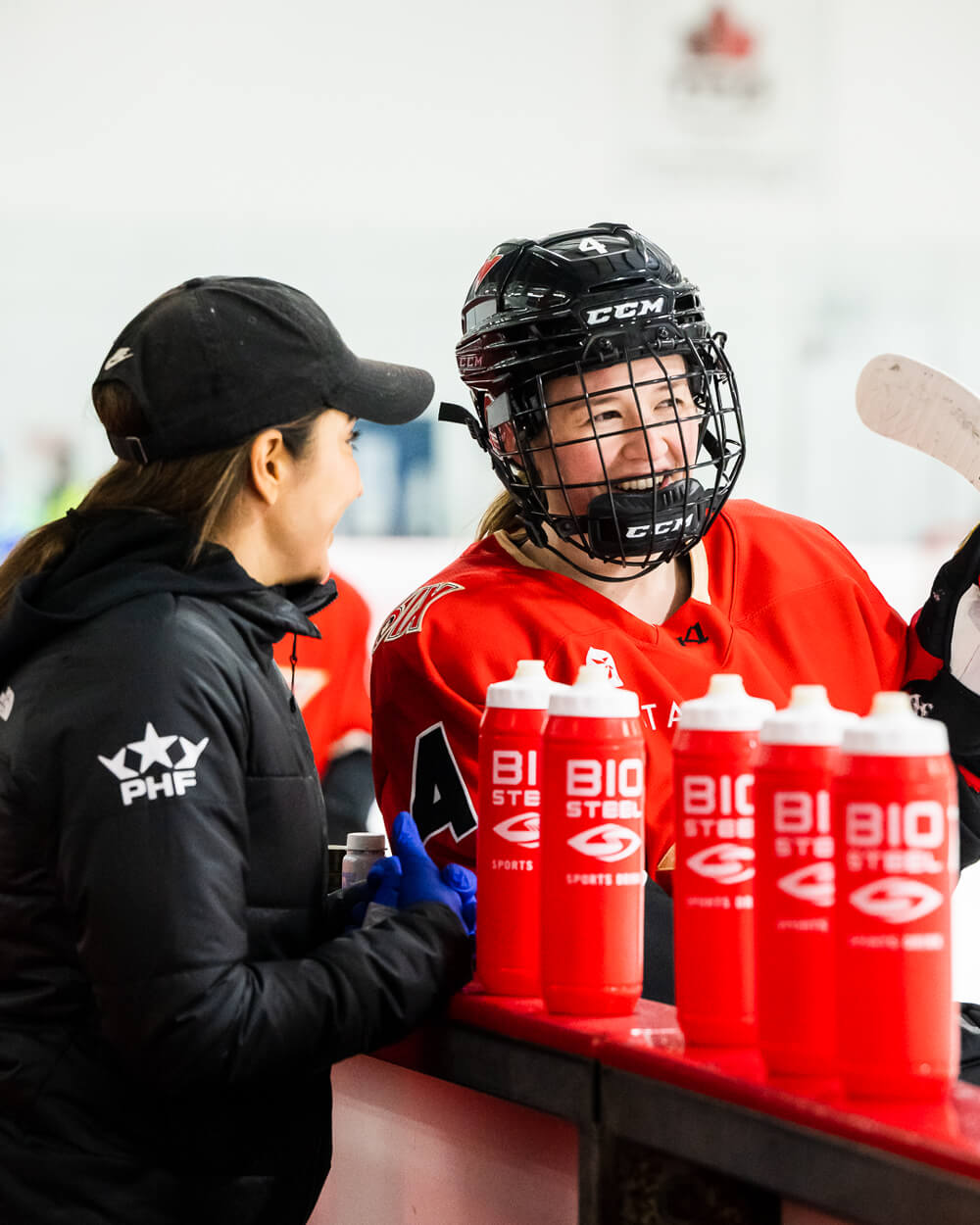
O
nce the terms of her contract were released, Watts got a stream of texts from friends and family members and former teammates chiming in to send their congratulations.
“I just didn’t know the impact it would have on so many people,” she says. “So, that’s been great to see.”
The PHF does not mandate the release of salary information — that decision is entirely each player’s to make. But Watts knew she wanted to make hers public, to show her peers that things are changing — that you can love the game, play the game, and earn a competitive wage in the process.
“Releasing the contract was important because players from other leagues, hopefully — and they have — they see this big number and hopefully they think in their heads, ‘Wow, okay, this is serious money. No other league in the women’s hockey world has this money,’” she says. “’So, if I want to be paid like a true professional, I need to join the PHF for next season so that, you know, my dream of making a healthy income will come true.’
“The PHF looks really incredible because of the money they can make.”
While she held off making it public for a week after signing, wanting first to acquaint herself with her new teammates, Watts believes the message her contract sends about the trajectory of the league, and women’s hockey overall, is an important one.
“It feels good to be rewarded for, I guess, my hockey resumé, my NCAA career, my objective statistics,” she says. “And I think that’s also a great message to players in the NCAA today who are performing at a really high level, like, putting up points: You will be rewarded. Maybe not by the national team, but you’ll be rewarded with a dollar figure for your performance in the way that NHL players are — you know, the highest point-getters in the NHL get the best contracts.
“It’s been fun to talk to some of the younger girls on Wisconsin right now who are really incredible players because it’s like, ‘Look at what’s waiting for you in three years,’” she continues. “It’s just so exciting for them. I’m really trying to encourage them to, you know, keep it up and get rewarded for it.”
Being the PHF’s highest-salaried player isn’t a title Watts ever expected to hold, and she says it’s not one she wants to keep. She hopes this deal opens the door for even bigger contracts to be signed this off-season. “It should be a cycle, the bar raised each time. You see that in the NHL,” she says. “My salary should just continue to push the next deals up and up and up. And we’re not making millions of dollars. It’s still about just trying to have a good lifestyle.”
After a long layoff — between her final game with the Badgers last March and her first practice with the Six in January, Watts hadn’t once laced up her skates — she’s starting to feel more like her old self.
“I’m not at 100 per cent right now, so it’s like, ‘Oh, I’m the highest-paid women’s hockey player — well, you know, I better start performing like it.’ But I’m not trying to be too hard on myself,” she says.
Watts is viewing this stretch of games like a runway on which she’s picking up speed before she really takes off.
“I want to help this team win a championship. Like, what’s better than helping your team win the championship? I feel right now, like, I’m not — and it hurts me to say this — I’m not helping my team win games right now just because I’m not at the level that I want to be at,” she says. “I want to be playing with all my abilities by the time playoffs come.
“I’m just really looking forward to being myself on the ice. It’s been a grind and I’m still not there yet, but hopefully [by the playoffs]I’ll be there.”
James understands Watts will take more time to “get up to game speed.” A major negotiating point, in fact, was her insisting Watts join the team right away — not next season, as was Watts’ initial intention — so she could make an impact come playoff time this spring. Watts registered her first career assist in her PHF debut on Jan. 21 and scored her first goal in game No. 4 on Feb. 5. Her best outing yet, a two-assist effort against the Minnesota Whitecaps in her 10th game, helped the Six complete the series sweep and clinch a top-two place in the league standings as well as home-ice advantage for the first round of the playoffs. Toronto concludes the regular season at home this weekend against the first-place Boston Pride with the No. 1 seed on the line.
When she’s not on the ice, Watts is working with NHL trainer Gary Roberts to build back the muscle she’d purposely been trying to shed in retirement. She’s excited to see her five-foot-six frame undergo another transformation — one that more closely follows the trend we see in today’s NHL of lean upper-bodies with all the power coming from a strong base.
“I don’t need the big shoulders, the big traps, that I had at Wisconsin. I’m trying to shed that so I’m light, so I’ll be faster,” she says.
As for her competitiveness and desire to win it all? That never left her.
“Playoff hockey is the best time of the year. It’s what you work for from the beginning of the season. I wasn’t there at the beginning of the season, but now I’m here,” she says. “I just think of winning the national championship. That was the best time of my life. So, winning the Isobel Cup, what could be better?”
Watts is embracing the hockey career she earned, but never expected, and now when she looks ahead to her future, she sees that it’s possible to reach her goals on skates.
Lori Bolliger Photography/Toronto Six (2); Justin Berl/NCAA Photos/NCAA Photos via Getty Images;Lori Bolliger Photography/Toronto Six.


